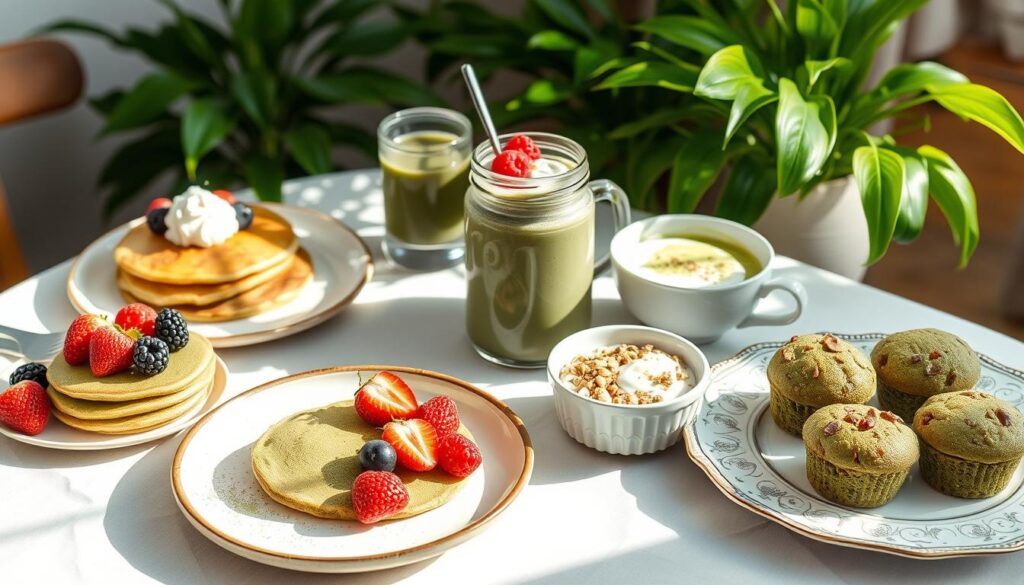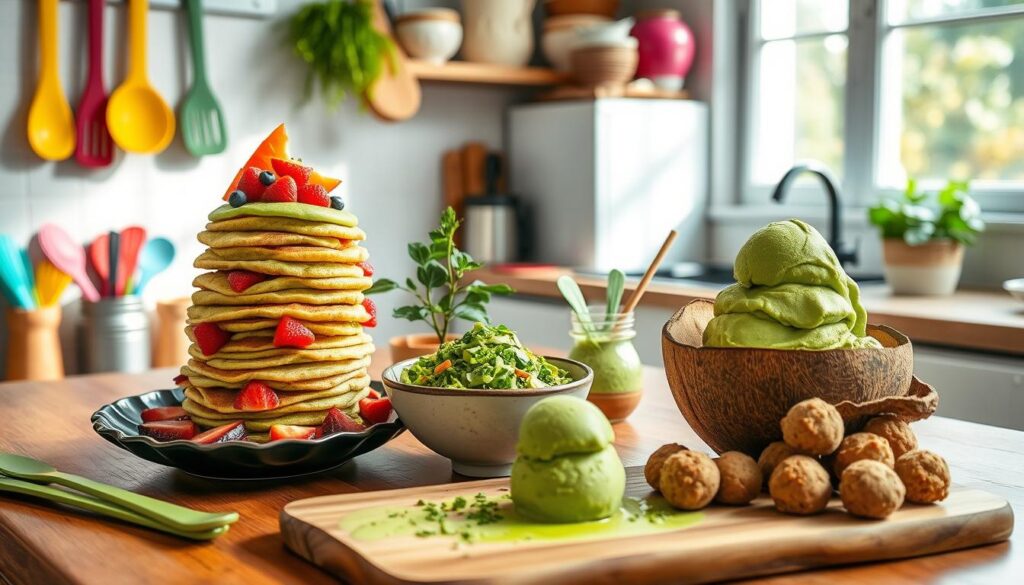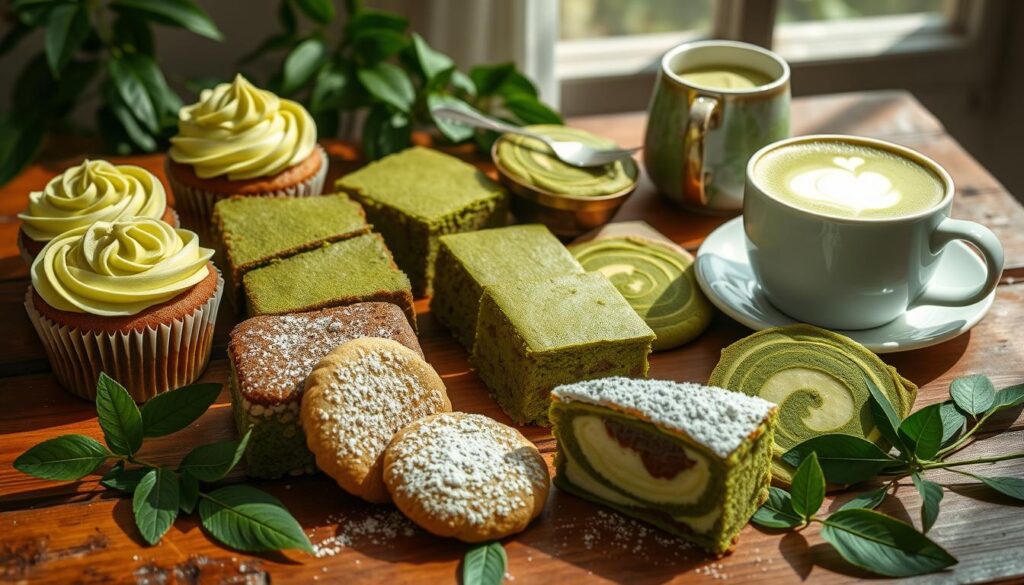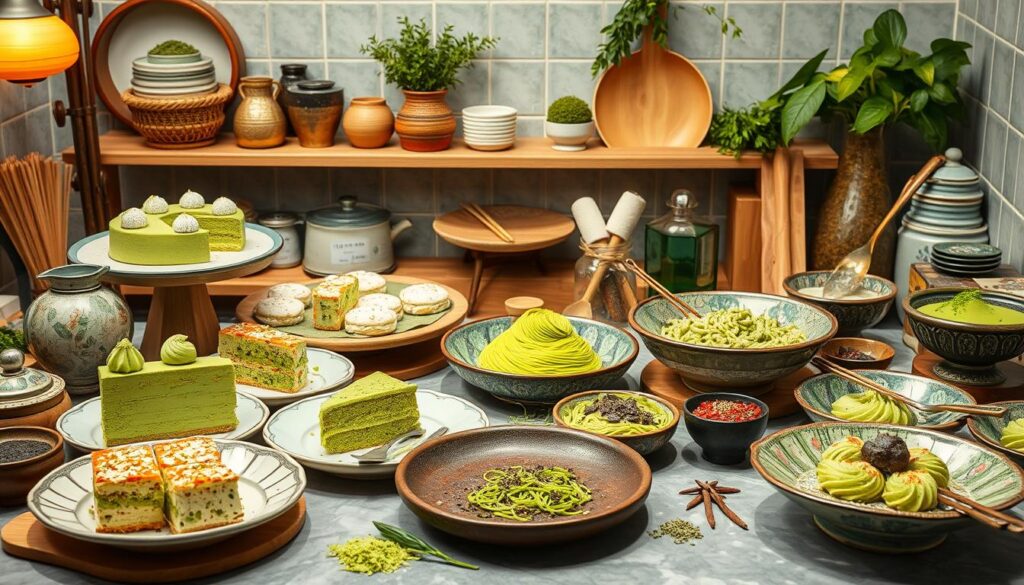Green tea powder has become more than just a drink. It’s now a key ingredient in cooking and baking, loved by food lovers everywhere. Matcha recipes now include more than just lattes. They’ve grown into a world of exciting dishes that surprise and please.
The bright green color and special taste of matcha make it perfect for adding something special to meals. Whether you’re an experienced cook or just starting out, matcha can open up a world of new recipes. These recipes are far beyond what you’d find at your local coffee shop.
Think about turning simple breakfasts, rich desserts, and even savory dishes into something amazing with matcha. This adventure will show you how this ancient Japanese ingredient can change your cooking forever.
Key Takeaways
- Matcha extends far beyond traditional tea drinks
- Green tea powder offers unique flavor and nutritional benefits
- Culinary matcha can be used in sweet and savory recipes
- Experimental cooking with matcha creates exciting taste experiences
- Understanding matcha’s versatility opens new cooking possibilities
Understanding Matcha: From Traditional Tea to Modern Ingredient
Matcha is a journey through Japanese traditions. It’s a green tea powder that has changed from a sacred tea in ancient ceremonies to a favorite ingredient globally.
Matcha’s history in Japan goes back to the 12th century. Buddhist monks first used powdered tea. They found grinding tea leaves into a fine powder made a stronger, more concentrated drink.
The Cultural Significance of Matcha in Japanese Tea Ceremonies
Japanese tea ceremonies make matcha more than just a drink. It’s a spiritual practice. Key parts include:
- Ritualistic preparation and presentation
- Meditation and mindfulness
- Symbolic gestures of respect and harmony
“The way of tea is not about drinking, but about inner peace and connection.” – Traditional Japanese Tea Master
Nutritional Benefits of Matcha Green Tea
Matcha is a nutritional powerhouse. It’s full of antioxidants. This green tea offers many health benefits:
- Boosts metabolism
- Enhances mental clarity
- Supports immune system
- Provides sustained energy
Different Grades of Matcha and Their Uses
Matcha grades show quality and use. Knowing these helps pick the right matcha for cooking:
| Grade | Quality | Typical Use |
|---|---|---|
| Ceremonial | Highest | Traditional tea ceremonies |
| Premium | High | Drinking and light cooking |
| Culinary | Standard | Baking and cooking |
Each matcha grade has its own special qualities. This makes matcha versatile for both traditional and modern cooking.
Essential Tools and Equipment for Matcha Preparation
To make the perfect matcha, you need special tools. These tools turn a simple drink into a flavorful ritual. It’s all about the tradition and taste.

Matcha lovers need a few key tools for a great green tea experience. Here are the must-haves:
- Bamboo whisk (chasen)
- Matcha bowl (chawan)
- Matcha sifter
- Measuring scoop
- Fine mesh strainer
The bamboo whisk is the most important tool. Made from bamboo, it makes matcha smooth and frothy. This is what makes high-quality matcha special.
“A proper bamboo whisk transforms matcha from a simple drink to an art form.” – Japanese Tea Masters
Now, let’s look at the main features of matcha tools:
| Tool | Purpose | Material |
|---|---|---|
| Bamboo Whisk | Mixing and creating foam | Bamboo |
| Matcha Bowl | Brewing and serving | Ceramic |
| Sifter | Removing clumps | Metal mesh |
Good matcha tools mean no clumps and a true taste. Each tool has its role. From sifting to whisking, they all help make the perfect matcha.
Sweet Matcha Breakfast Recipes
Start your day with matcha breakfast ideas that are both tasty and healthy. These recipes turn simple breakfasts into special meals. Learn how to add matcha to your morning for a boost of energy.

Matcha is more than a trendy drink. It’s a key ingredient that can change your breakfast. It’s full of antioxidants and helps boost your metabolism. These recipes will make your mornings exciting and nutritious.
Matcha Overnight Oats with Fresh Berries
Make your matcha oats into a creamy breakfast that’s easy to prepare. Here’s a simple recipe to start with:
- 1/2 cup rolled oats
- 1 tsp high-quality matcha powder
- 1 cup almond milk
- 1 tbsp honey
- Fresh mixed berries for topping
“Overnight oats are the ultimate make-ahead breakfast for busy mornings!” – Nutrition Expert
Fluffy Matcha Pancakes
Make your weekend breakfast special with these light matcha pancakes. They’re not just pretty but also full of antioxidants.
Green Tea Granola Bars
Make these healthy matcha granola bars for quick breakfasts. They’re full of nuts, seeds, and matcha for energy all morning.
- Combine rolled oats, nuts, and seeds
- Mix in matcha powder for an extra boost
- Bind with honey or maple syrup
- Bake until golden and crisp
These matcha breakfast ideas show that healthy food can be fun. Try these recipes and find your new favorite morning dish!
Matcha Beyond the Latte: Creative Recipes to Try

Matcha is more than just a trendy drink. Food lovers are finding new ways to use this vibrant green powder. They turn simple dishes into amazing culinary experiences.
Exploring matcha’s uses in cooking opens a world of creativity. It can be used in both savory and sweet dishes. This makes it a versatile ingredient for recipe transformations.
- Unexpected Savory Applications
- Matcha-infused risotto
- Green tea pasta dough
- Matcha seasoning rubs for meats
- Creative Sweet Innovations
- Matcha energy balls
- Green tea ice cream
- Matcha-swirled cheesecake
“Matcha isn’t just an ingredient—it’s a canvas for culinary imagination.” – Culinary Institute of America
These recipes show how matcha can make home cooking special. Chefs and home cooks are using matcha to create new dishes. They’re turning traditional recipes into exciting ones.
To make great matcha dishes, know its unique taste. Start with a little and add more until it’s just right. This way, you can find the perfect balance in your dishes.
Matcha-Infused Baked Goods

Matcha baking turns simple desserts into amazing treats. Green tea baked goods add a unique twist to classic recipes. They bring vibrant color and rich flavor to your kitchen.
The earthy taste of matcha makes sweet treats sophisticated. It pleases both professional bakers and home cooks.
Discovering matcha desserts shows how this green tea powder can elevate baking. Its intense green color and subtle umami flavor make it perfect for memorable baked goods.
Classic Matcha Pound Cake
The matcha pound cake is a great start to green tea baked goods. It has a dense, moist texture and a beautiful emerald color. The ingredients include:
- High-quality culinary grade matcha
- Unsalted butter
- Granulated sugar
- Eggs
- All-purpose flour
Green Tea Chocolate Chip Cookies
Try a matcha twist on the classic chocolate chip cookie. These cookies mix traditional sweetness with green tea’s complex flavor. They are a unique dessert that will surprise and delight you.
Matcha Muffins with White Chocolate
Soft, fluffy muffins with creamy white chocolate chunks are a decadent treat. The mix of sweet white chocolate and earthy matcha is perfect for breakfast or afternoon snacks.
“Matcha transforms ordinary baking into an art form, bringing depth and complexity to every bite.” – Culinary Enthusiast
Refreshing Matcha Smoothies and Drinks
Beat the heat with delicious matcha smoothies. They turn your favorite green tea into a cool, nutritious treat. These drinks offer a perfect mix of flavor and wellness, great for those who care about their health.
To make the best iced matcha drinks, start with high-quality matcha powder. Try unique ingredient combinations to make your smoothies special. Innovative recipes can turn ordinary matcha smoothies into extraordinary culinary delights.
- Classic Matcha Green SmoothieBlend spinach, banana, almond milk, and matcha powder for a nutrient-packed drink
- Tropical Matcha SmoothieCombine mango, pineapple, coconut water, and matcha for a refreshing tropical twist
- Protein-Packed Matcha SmoothieMix vanilla protein powder, Greek yogurt, and matcha for a post-workout boost
“Matcha isn’t just a drink, it’s a lifestyle of wellness and flavor.” – Matcha Enthusiast
Try different liquid bases like coconut milk, almond milk, or green tea. This creates unique matcha beverages that match your taste. The key is to balance the earthy matcha flavor with ingredients that enhance it.
| Matcha Smoothie Type | Key Ingredients | Nutritional Benefit |
|---|---|---|
| Green Detox Smoothie | Matcha, Kale, Apple, Lemon | Antioxidant-rich, Supports Metabolism |
| Berry Matcha Blast | Matcha, Mixed Berries, Almond Milk | Supports Immune System |
Pro tip: Use cold ingredients and blend well for a smooth, creamy texture. Garnish with chia seeds, fresh mint, or matcha powder for a great look.
Savory Dishes Featuring Matcha
Matcha isn’t just for lattes and desserts. Chefs and home cooks are finding new ways to use it in savory dishes. The unique umami flavor of matcha can turn simple dishes into something special.
Exploring matcha in cooking opens up a world of creative possibilities. This versatile ingredient adds depth, color, and nutrition to main courses and side dishes.
Matcha Salt for Seasoning
Create a gourmet matcha seasoning that elevates any dish. To make matcha salt:
- Mix 2 tablespoons of high-quality matcha powder with 1/4 cup sea salt
- Blend thoroughly to ensure even distribution
- Store in an airtight container
“Matcha salt transforms simple ingredients into restaurant-quality creations” – Culinary Experts
Green Tea Noodles
Infuse pasta with the distinctive flavor of matcha. Homemade green tea noodles offer a stunning visual and taste experience in matcha cooking.
- Mix 1-2 teaspoons of matcha into pasta dough
- Knead until color is uniform
- Roll and cut noodles as usual
Matcha-Crusted Fish
A sophisticated approach to seafood preparation involves creating a matcha seasoning crust. This technique adds a crisp texture and earthy undertone to fish fillets.
- Combine matcha powder with breadcrumbs
- Coat fish in egg wash
- Press matcha mixture onto fish
- Bake or pan-sear until golden
These savory matcha recipes show how amazing this traditional Japanese ingredient can be in modern cooking.
Matcha Desserts and Sweet Treats
Matcha desserts have become a big hit in the world of food. They turn green tea into amazing sweet treats. These treats mix earthy flavors with sweet notes, making everyone love them.
- Creamy matcha ice cream with rich, smooth texture
- Delicate matcha truffles with chocolate coating
- Soft matcha macarons with subtle green tea notes
- Decadent matcha cheesecake garnished with fresh berries
Matcha desserts are amazing because they can be so different. Green tea sweets can be light and refreshing or rich and indulgent. They please many different tastes.
“Matcha transforms ordinary desserts into extraordinary culinary experiences.” – Culinary Experts
Professional pastry chefs love using matcha in their desserts. They mix green tea flavors with classic sweets in new ways.
| Matcha Dessert | Flavor Profile | Difficulty Level |
|---|---|---|
| Matcha Ice Cream | Creamy, Earthy | Easy |
| Matcha Truffles | Rich, Intense | Moderate |
| Matcha Tiramisu | Complex, Smooth | Advanced |
Whether you’re a pro baker or just love desserts, matcha treats are a fun journey. They mix Japanese flavors with modern baking techniques.
Tips for Storing and Preserving Matcha Quality
Storing matcha right is key to keeping its bright taste and health benefits. Green tea lovers know that keeping it fresh makes a big difference.
Matcha is very delicate and needs careful handling. It’s important to protect it from things that could harm it. This helps keep its special qualities.
Selecting the Right Storage Containers
The container you use affects how long your matcha stays good. The best ones are:
- Opaque, airtight ceramic containers
- Dark glass jars with tight-fitting lids
- Vacuum-sealed packages
Temperature and Humidity Management
How you store matcha matters a lot. For the best results, keep it:
- Cool (below 68°F)
- In a dry place
- Away from sunlight
Matcha Shelf Life Guidelines
| Storage Method | Recommended Duration | Quality Preservation |
|---|---|---|
| Unopened Sealed Package | 12-18 months | Excellent |
| Opened Container | 4-6 weeks | Good |
| Refrigerated | 2-3 months | Very Good |
“Treat matcha like a fine wine – with respect, care, and proper storage.” – Tea Preservation Expert
Using these storage tips will help your matcha stay fresh and full of flavor for longer.
Common Mistakes to Avoid When Cooking with Matcha
Mastering matcha cooking needs precision and knowledge. Many home cooks make mistakes that ruin the flavor and color of matcha. Knowing about these mistakes helps you make better matcha dishes.
Here are some key matcha cooking tips to improve your skills:
- Avoid using boiling water, which burns matcha and creates a bitter taste
- Never store matcha in transparent containers exposed to light
- Measure matcha powder precisely to maintain balanced flavors
- Sift matcha powder to prevent clumping in recipes
Temperature control is key when using matcha. Ideal brewing temperature ranges between 175-180°F. This keeps its flavors delicate. Chefs suggest using a digital thermometer for accuracy.
“Matcha is an art form – treat it with respect, and it will reward you with incredible flavors.” – Traditional Japanese Tea Master
Knowing matcha best practices means understanding that not all matcha is the same. Culinary-grade matcha is different from ceremonial-grade and needs different preparation. Choose the right grade for your recipe for the best results.
- Ceremonial grade: Best for traditional tea and minimal cooking
- Premium grade: Suitable for baking and smoothies
- Culinary grade: Ideal for complex recipes and cooking
By avoiding these common matcha mistakes, you’ll go from amateur to pro. You’ll make dishes that are vibrant and full of flavor, showing off this amazing ingredient.
Conclusion
Your matcha culinary journey has just started. It opens up a world of exciting recipe ideas. This vibrant green tea powder can turn simple dishes into something special.
Matcha can be used in everything from sweet breakfast treats to savory dinner dishes. It’s perfect for both home cooks and professional chefs. It adds a unique touch to any meal.
Matcha’s magic lies in its ability to fit into many cuisines and recipes. It makes delicate pancakes, complex desserts, and unique seasoning blends even better. It adds nutritional value and a special earthy flavor to your dishes.
Don’t be shy to try new things. Each recipe is a chance to learn and grow. Start with simple recipes and get more confident as you try more complex ones.
Great cooking comes from passion, creativity, and a love for trying new things. Matcha is a great ingredient for exploring new flavors. It lets you create amazing meals that will impress your family and friends.
FAQ
What exactly is matcha?
Matcha is a finely ground powder from green tea leaves. It’s different from regular green tea because you drink the whole leaf. This gives you more nutrients and a rich flavor.
How is matcha different from regular green tea?
Regular green tea leaves are thrown away after steeping. But matcha is whisked into water, so you get the whole leaf. This makes matcha more nutritious and flavorful than steeped green tea.
What are the health benefits of matcha?
Matcha boosts metabolism and brain function. It’s good for heart health and full of antioxidants. It also has L-theanine for calm focus and overall wellness.
What grade of matcha should I use for cooking?
Use culinary grade matcha for cooking. It’s cheaper and has a strong flavor that works well with other ingredients. Ceremonial grade is best for drinking.
How should I store matcha to keep it fresh?
Store matcha in an airtight container away from light and heat. Keep it cool and dark, like a pantry or fridge. Use it within 1-2 months for the best taste and health benefits.
Can I make matcha if I don’t have a traditional bamboo whisk?
You can make matcha without a bamboo whisk. Use a kitchen whisk, blender, or shaker bottle. But, they won’t make it as smooth as a bamboo whisk.
Is matcha safe for everyone to consume?
Matcha is usually safe, but it has caffeine. People sensitive to caffeine should be careful. Pregnant women and those with certain health issues should talk to their doctor before trying matcha.
How much matcha should I consume daily?
Experts say 1-2 teaspoons of matcha powder a day is best. This is about 1-2 cups of tea. It’s healthy without too much caffeine. But, listen to your body and adjust as needed.
Can I use matcha in recipes other than drinks?
Yes! Matcha is great in many recipes. Try it in baked goods, breakfast items, smoothies, ice cream, and even savory dishes. It adds a unique flavor to many recipes.
What does matcha taste like?
Matcha tastes complex, with notes of grassy, umami, and slightly bitter. High-quality matcha is smooth and rich, with a hint of sweetness. The taste can change based on the tea’s grade and origin.
Share this post: on Twitter on Facebook

